Content Strategy Framework that Works: Main Steps to Create

If you don't yet have a content strategy framework to promote your business online, it's time to work on it. Why is this so important?
With a content strategy framework, you combine the potency of SEO tactics with the personalized touch of customer-centric marketing. Put simply, you bridge the gap between search engine dictates and your audience's genuine needs.
A content framework provides clarity, coherence, and a tangible roadmap for experimentation and enhancement in your marketing campaigns.
If you're still figuring out the concept of a content strategy framework, we can help. This article is your step-by-step guide for building a working content strategy framework. The key stages include goal setting, conducting the persona research, using content tools, and others.
Let's begin our research!
What is a content strategy framework?
Crafting a content strategy framework is the compass for all your initiatives related to content marketing. It outlines the intricacies of content creation, management, publication, promotion, and upkeep, all of which are aligned with your brand objectives.
Creating such a plan means visualizing this framework in a tangible format—a Google Doc, spreadsheet, or scribble on a notepad. This blueprint becomes a navigational tool, guiding every stage of your successful content marketing journey.
It's imperative to understand that strategy creation isn't a one-and-done affair. You should keep your finger on the pulse and be prepared to make any needed corrections.
By the way, 80 percent of marketers stated they thought their content strategy was very thriving. This approach works, but you need to build this strategy wisely.
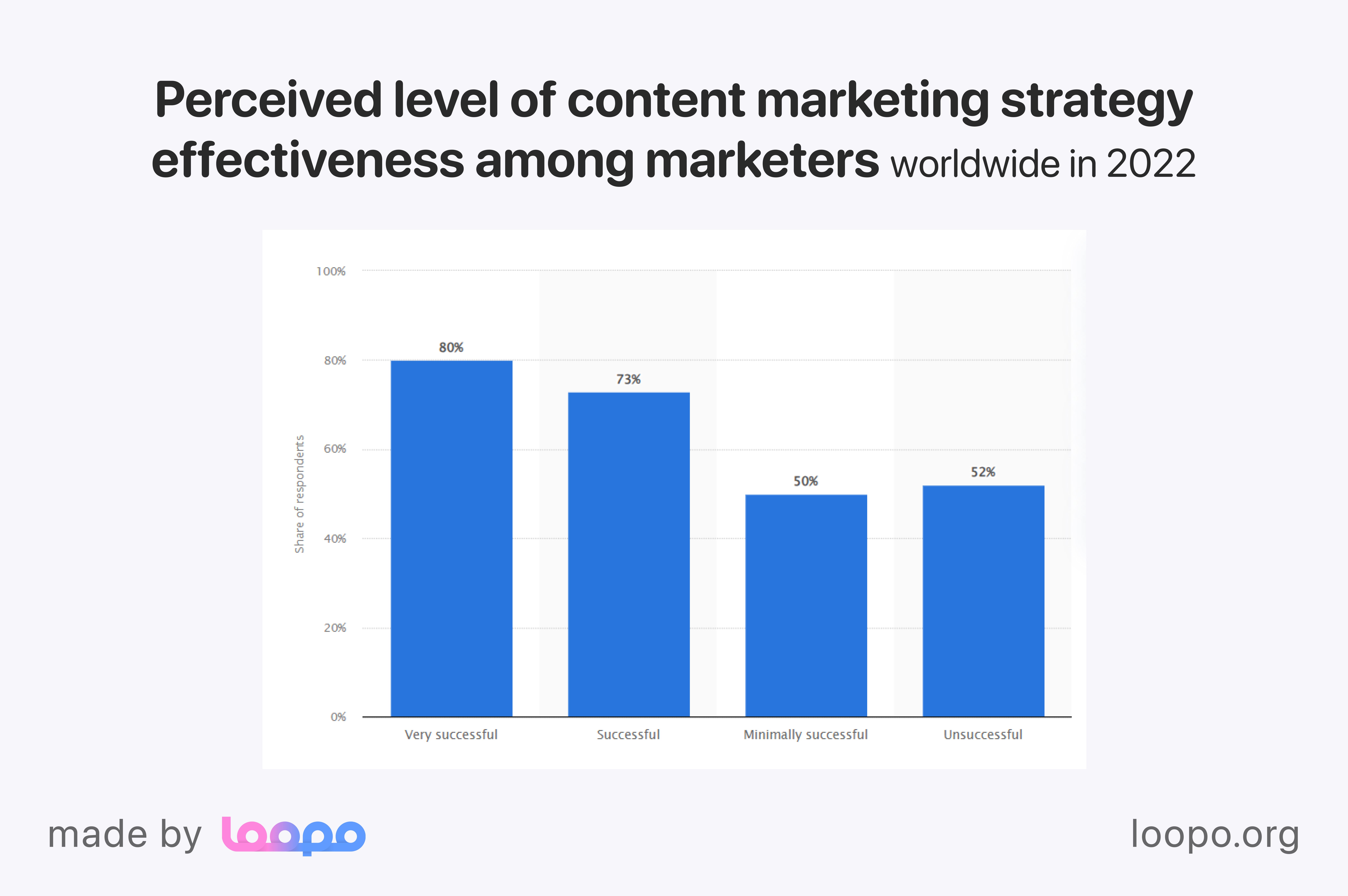
Key elements of the content creation strategy
What constitutes the essential elements of a content strategy framework? The four core pillars of a content strategy framework typically encompass:
Audience understanding: Central to this pillar is comprehending your target demographic. You must grasp their demographics, preferences, pain points, and behavioral patterns. Crafting buyer personas or user profiles proves invaluable in this endeavor.
Content development: This pillar entails the meticulous planning and creation of pertinent, valuable, and top-notch content. It spans a diverse array of content formats, including but not limited to blog posts, videos, infographics, and podcasts, tailored to your audience's interests and requirements.
Distribution and promotion: Once content is crafted, a strategic approach is imperative to ensure its visibility among your audience. This involves selecting suitable dissemination channels (social media, email marketing), scheduling posts, and contemplating paid promotion if needed.
- Measurement and analysis: At the heart of this pillar lies monitoring the performance of your content marketing endeavors. Defining key performance indicators (KPIs) and consistently analyzing data are essential to assessing the efficacy of your content strategy. These insights should inform subsequent adjustments and enhancements.
Need a tool to manage your marketing content? Try Loopo. Register today!
How to develop a framework for content marketing: step-by-step guide
Below are the main steps to create a winning content strategy that will help to increase sales.
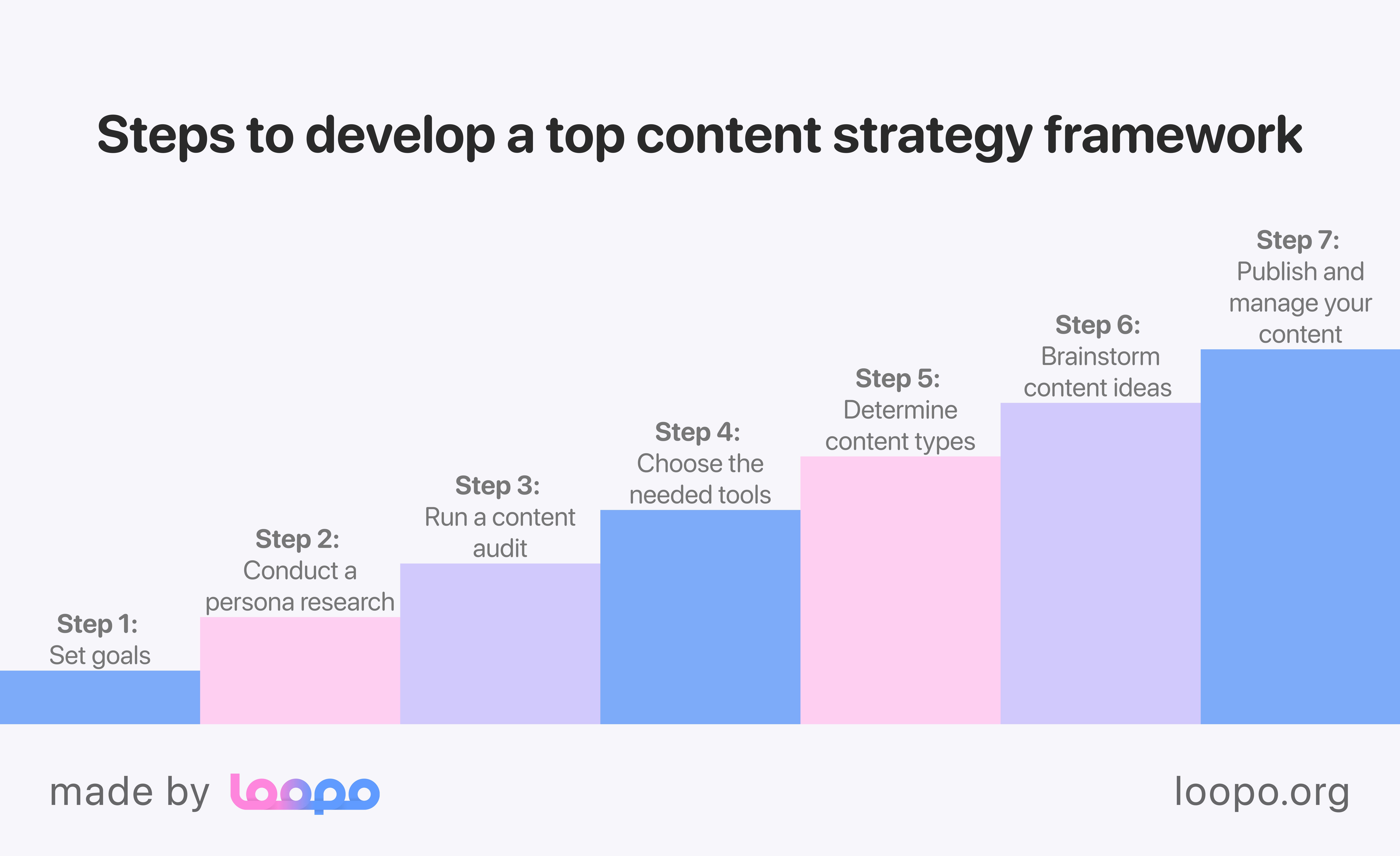
Step 1: Set goals
Before initiating any business venture, it's imperative to delineate your objectives. What are your final goals? What outcomes do you seek? And how can a framework facilitate their realization? Find time in this initial phase to delineate your goals and objectives.
Ensure simplicity and specificity by adhering to the template: what + why + how. For example, if your aim is to boost website traffic, your objective might be articulated as follows:
"I aim to augment our website traffic by 10%. We've seen a correlation between heightened website traffic and enhanced program sign-ups. To achieve this, we intend to increase site traffic by incorporating additional ultimate guides and 3000-word articles into our blog."
The core of exceptional businesses lies in their ability to tackle issues effectively. Thus, in this stage, delve into the challenges your content aims to tackle and the corresponding solutions it seeks to furnish.
In this phase, articulate the specific factors that will distinguish you apart from competitors. For instance, does your product boast a five-year warranty, supplemented by video tutorials and round-the-clock customer support? Do you incentivize clients enrolled in your 30-day program with upgraded one-on-one coaching sessions? Is your SaaS solution distinguished by an exclusive client portal featuring in-app messaging capabilities? Identify and emphasize what makes your offering exceptional.
Step 2: Conduct a persona research
A buyer persona is a supposed portrayal of your ideal customer shaped by data and research. It offers insights into the individuals for whom you're crafting content. Developing a precise audience persona entails conducting research via surveys and interviews, as well as analyzing social media interactions to glean valuable insights.
These insights encompass various aspects such as demographic details, interests, challenges, and content preferences of your audience. Having this knowledge enables you to discern the most effective content formats, subjects, and marketing channels that align with your objectives.
Refine your focus on a distinct target demographic. What characterizes their user behavior? What touchpoints do they typically encounter in their interactions with your brand? Segment your audience by funnel stage and type. Then, strategize how to support each audience segment throughout their buyer's journey. Tailor your content offerings to align with their specific needs and progression in the sales funnel.
For example, prospects in the research phase may benefit from interactive quiz landing pages, providing solutions while positioning your product or service as the optimal solution.
Step 3: Run a content audit
Once you've established your audience persona, it's time to assess your existing content to discern its effectiveness. By doing so, you can reveal areas of strength and find areas for improvement in your content strategy.
In your content strategy blueprint, you should determine the following points:
The types of content and subjects that resonate well with your audience (blogs focusing on web development, short videos offering coding tips and tricks).
The types of content and subjects that are failing to engage your audience (whitepapers exploring the evolution of programming).
The content gaps and opportunities that have surfaced through your evaluation.
You can apply tools like social media analytics or Google Analytics to analyze your content's performance. Look for trends in the types of content that perform exceptionally well, and use this data to guide your future content creation endeavors.
Also, it is essential to determine who is responsible for each facet of your content marketing strategy. As you assemble your content team, these pivotal roles may warrant consideration (with one individual potentially assuming multiple responsibilities based on resource availability):
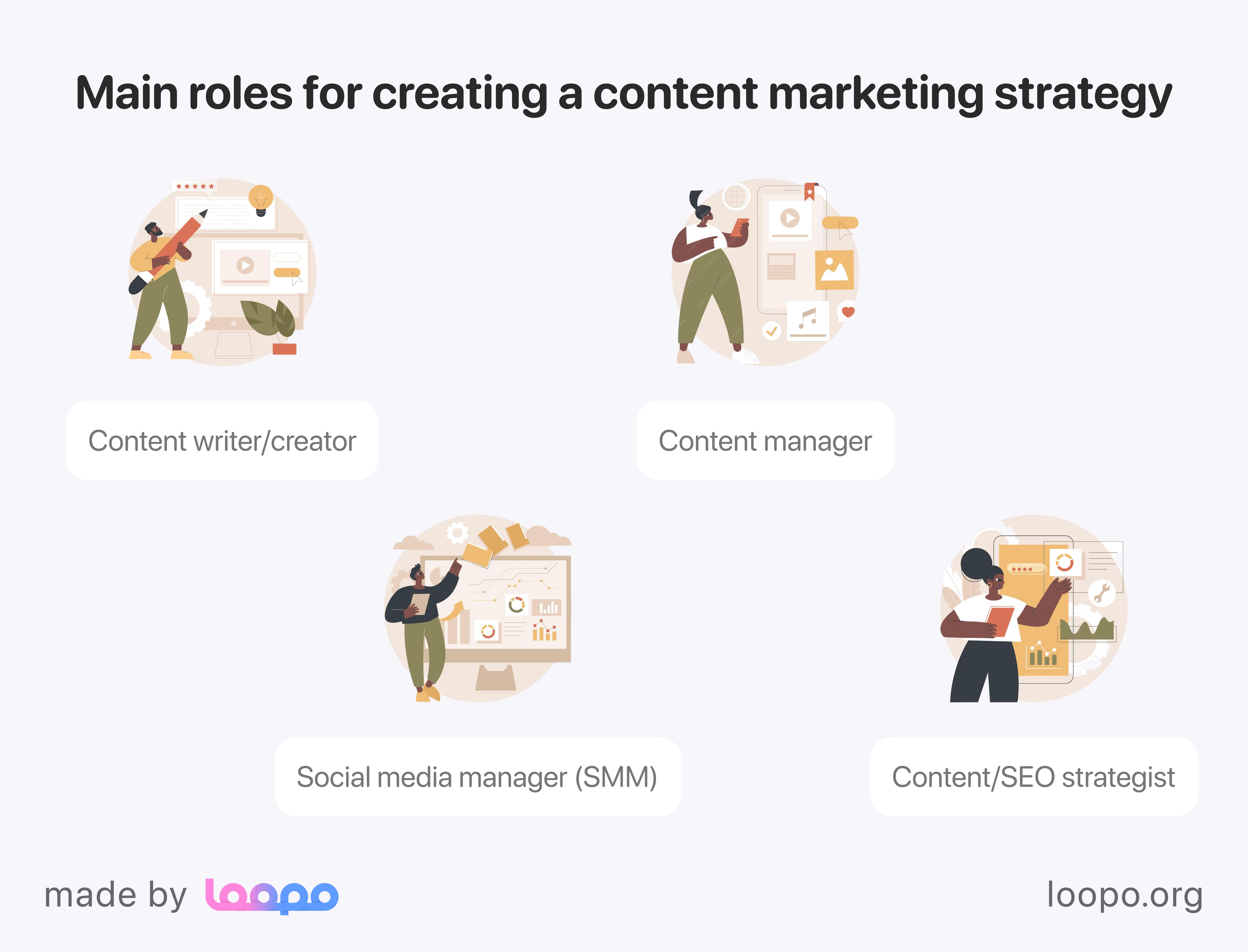
Content writer/creator: You require someone adept at crafting written content in various formats, including blogs, ebooks, whitepapers, webpages, and social media posts. Alternatively, individuals proficient in those mediums are indispensable if you opt for video or infographics.
Content manager: Who will oversee the administration of blog posts, including formatting, scheduling, and publication?
Social media manager (SMM): Who will handle social media posting and engage with your target group?
Content/SEO strategist: Who will research keywords and explore blog topics? Who will generate content ideas? Who will monitor metrics and evaluate outcomes?
Want a top content management tool? Choose Loopo. Get a free trial!
Step 4: Choose the needed tools
Armed with clarity regarding your goals and target audience, it's imperative to select the appropriate tools to support your endeavors.
While essential tools include SEO (search engine optimization), grammar checking, and plagiarism detection, a robust content management system is necessary. Choose tools that streamline content creation, publication, and management processes, facilitating seamless execution of your content strategy.
Here are some of the essential tools:
Keyword research or SEO tools (Semrush, Ahrefs).
Web analytics tool (Google Analytics).
Content management system (WordPress, Drupal, Joomla).
Content calendar (Airtable, Trello, CoSchedule, Google or Excel spreadsheets, Loopo).
Here are the nice-to-have tools:
Editing software (Grammarly).
SEO checker (Yoast).
Conversion rate optimization (CRO) tool (Hotjar).
Image editing tool (Canva or Photoshop).
Step 5: Determine content types
Deliberate on the content formats you intend to prioritize and the channels through which you'll disseminate your content. Develop strategies for content creation and publication management.
Common content formats encompass thought leadership content, awareness content, and sales content. Subcategorize each format to include micro-content types. For instance, an e-commerce guide may serve as awareness content, while software listicles align with sales content. Ensure you track and measure pertinent marketing KPIs to gauge content performance accurately.
Some types of content you might consider:
Blog articles.
Videos.
Podcasts.
Social media content ( Instagram carousels, LinkedIn polls, TikTok videos).
Email newsletters.
The issue lies in discovering the channels that resonate most with the target group. For instance, a B2B (business-to-business) content strategy would prioritize LinkedIn as a primary channel, whereas a B2C (business-to-customer) approach might concentrate on platforms like Instagram or TikTok to reach younger demographics.
Additionally, if a company's blog receives minimal traffic, exploring guest posting opportunities on influential blogs within the niche, complete with backlinks to their own site, could enhance website visits. With numerous channels and opportunities available, it's crucial to pinpoint the most effective ones for your strategy.
Step 6: Brainstorm content ideas
After establishing a clear grasp of your audience and objectives, it's time to stimulate creativity by generating content ideas tailored to resonate with your target audience. Start by exploring themes that align with the identity of your brand and core values. Utilize insights gleaned from audience research to pinpoint their main needs, interests, and preferences.
Engage your team in collaborative brainstorming sessions where all members offer ideas. Encourage diversity in thought and foster an environment conducive to creativity to generate a wide array of content concepts. Experiment with brainstorming techniques like mind mapping, word association, or group discussions to spur idea generation.
Moreover, leverage resources such as keyword research tools, industry trends, and competitor analysis to uncover trending topics and relevant keywords. Explore various content formats and mediums that appeal to your audience, including podcasts, blog posts, engaging videos, or social media content.
Record your content ideas in a centralized repository or content calendar, categorized by themes, topics, and potential publication dates. Prioritize ideas based on their alignment with your content strategy objectives, relevance to your audience, and potential to drive desired outcomes.
Step 7: Publish and manage your content
With your content ideas in place, it's time to execute and manage them effectively. Develop a content calendar detailing your publishing schedule, including content creation, review, and publication dates. Your content calendar aligns with your overarching content strategy and helps you to navigate your marketing objectives.
You can use a convenient content calendar, such as Loopo. Here, you can easily schedule content for social networks, your blog, or your site. Also, using this tool, you can assign tasks and manage their completion simply.
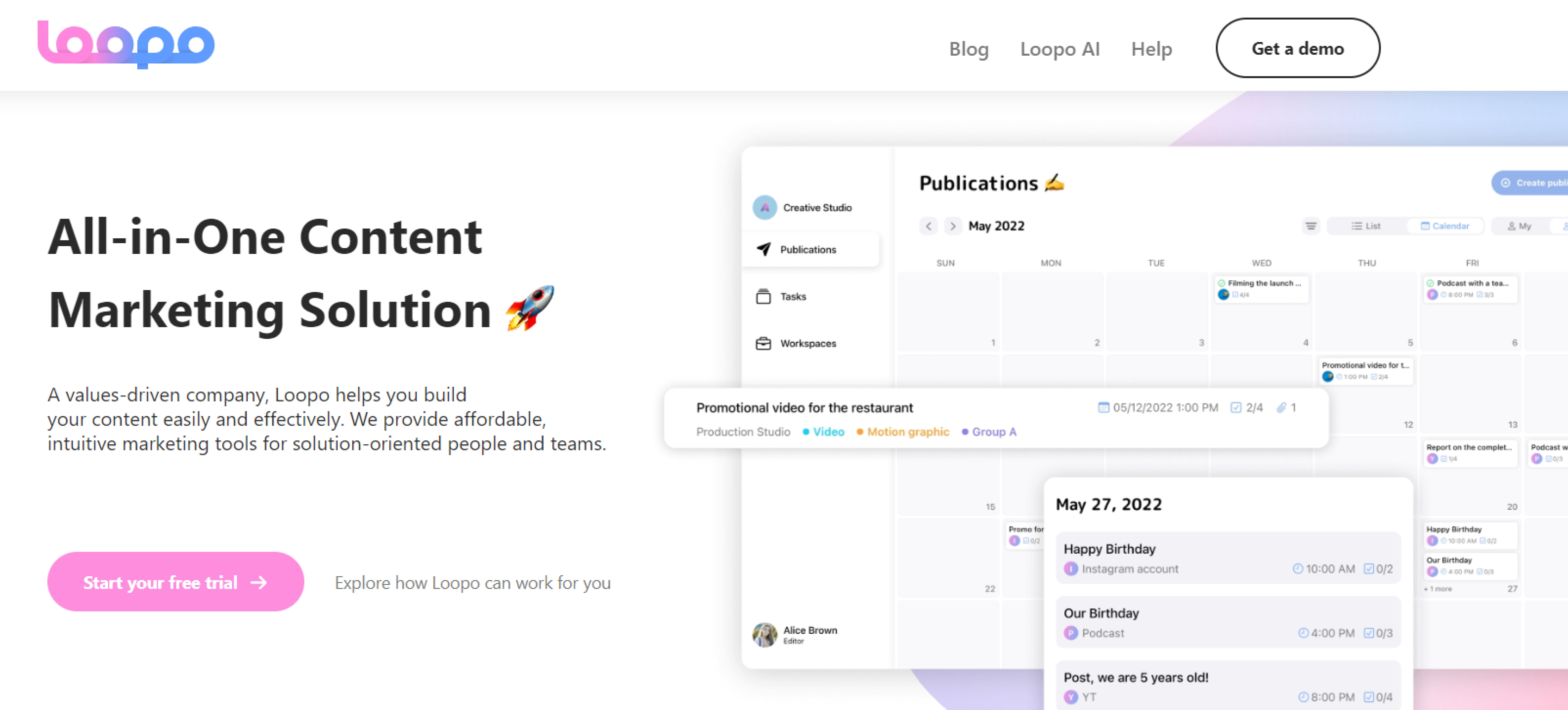
Assign responsibilities and roles to team members involved in content creation, editing, and publication to streamline workflow and ensure accountability. Establish standards and clear guidelines for content creation, including brand voice, style, tone, and quality benchmarks.
As you publish your content, leverage analytics tools to monitor its performance and assess its impact on key metrics such as website traffic, engagement, leads, and conversions. A content strategy framework should beeffective. Monitor audience feedback, comments, and social media interactions to gather ideas and refine your strategy as needed.
Regularly check and make changes in your content strategy based on audience feedback, performance data, and evolving industry dynamics. Continuously experiment with new ideas, formats, and distribution channels to keep your content fresh, relevant, and engaging for your audience.
By effectively executing and managing your content, you can maximize its effectiveness and drive visible results for your business.
What to add and avoid in your content creation framework
If you want to build a robust content strategy framework, you should carefully consider what to incorporate and steer clear of. Here's a detailed breakdown to help navigate this process:
What you should add:
Clearly defined objectives: Commence by delineating precise objectives for your content creation endeavors. Determine the outcomes you aspire to achieve, whether it involves heightening brand visibility, driving website traffic, generating leads, or nurturing customer relations.
Insights into the audience: Embed audience research to obtain profound insights into your target demographic. Identify their demographics, preferences, interests, pain points to tailor content that resonates better.
Content guidelines: Establish unequivocal guidelines for content creation, encompassing brand voice, tone, style, and quality benchmarks. Uphold consistency across all content assets to uphold brand integrity and enhance audience engagement.
Content calendar: Formulate a content calendar delineating your publishing schedule and content topics. This will aid in organization, consistency, and prompt content delivery to your audience.
Diverse content formats: Experiment with an array of content formats, such as videos, blog posts, infographics, podcasts, and social media content. Determine which type of content receives the most response from the people.
What to avoid:
Absence of strategy: Avoid forging ahead with content creation without a well-defined strategy. Random content production devoid of alignment with business objectives and audience needs can result in inefficacious outcomes and squandered resources.
Neglecting audience feedback: Refrain from disregarding audience feedback and insights. Monitor audience engagement metrics, comments, and feedback to discern what resonates with your target group and refine your content strategy accordingly.
SEO oversight: Don't overlook the importance of SEO, which can limit the visibility and reach of your content. Infuse relevant keywords, optimize meta tags, and focus on crafting high-quality, valuable content that ranks favorably in search engine results.
Inconsistent branding: Avoid inconsistencies in brand messaging, voice, and visual identity across disparate content pieces. Cohesive branding bolsters brand recognition and cultivates trust and credibility with your audience.
Neglecting content distribution: Don't underestimate the significance of content distribution. Formulate a strategy to promote and disseminate your content across diverse channels, encompassing social media, email, and partnerships, to amplify its reach and impact.
By integrating these components into your content creation framework while evading common pitfalls, you can formulate a cohesive and effective strategy that resonates with your target group.
Want to manage marketing content with ease? Give Loopo a try. Start now!
Reasons why a content marketing strategy is a must
The content strategy framework offers many pros to help maximize the impact of content marketing efforts.
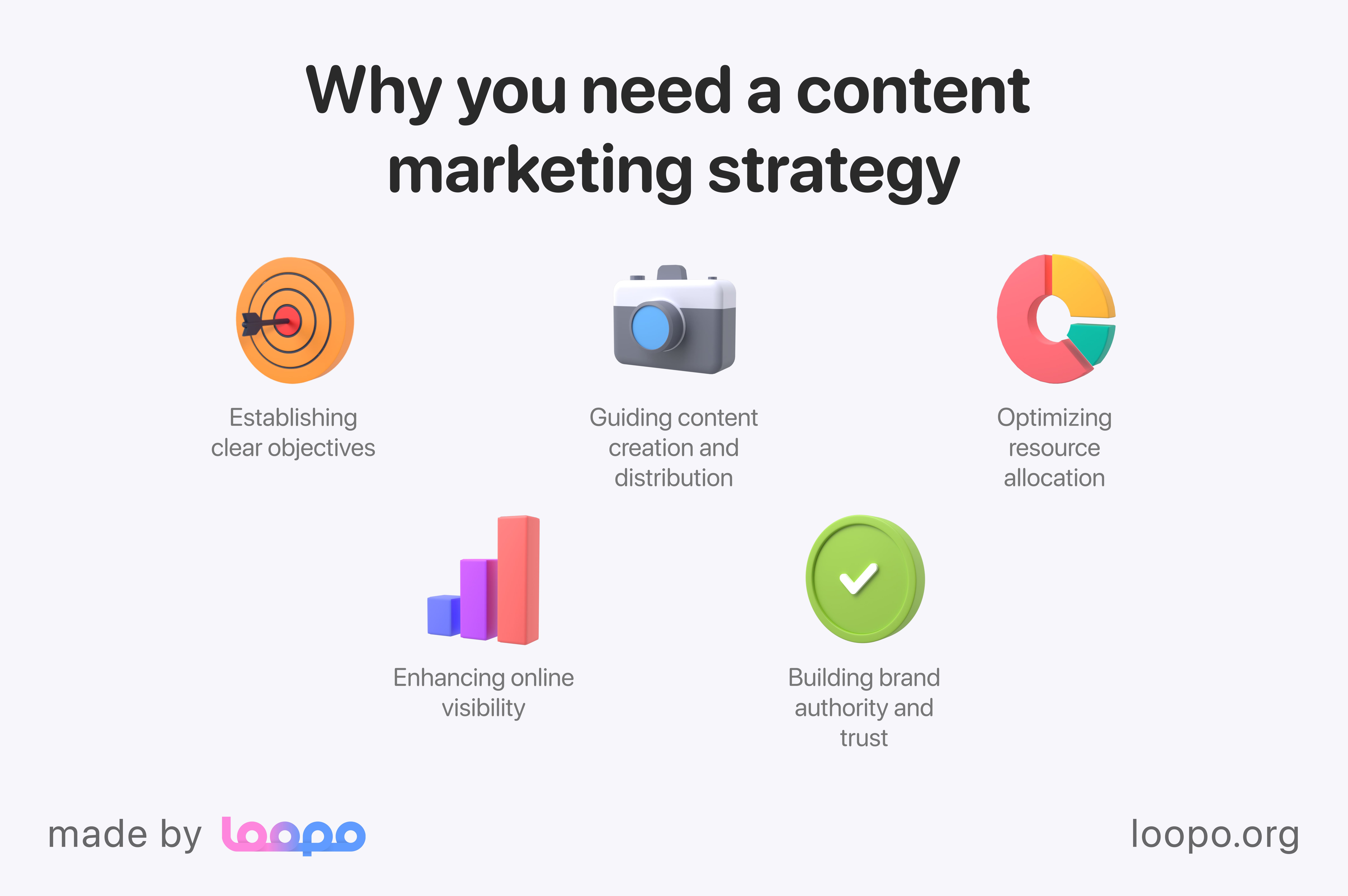
Establishing clear objectives
A content strategy framework ensures that every marketing team member comprehends the business's overarching objectives and specific goals. Content creators, social media managers, copywriters, and other specialists should be are aligned on goals like brand visibility, lead generation, or customer engagement. So, they can generate content that will help you to reach your marketing aims.
Guiding content creation and distribution
A content strategy necessitates planning the type of content to produce, such as videos, blog posts, and infographics. It also involves determining the most effective channels for distribution. These can be email marketing, social media platforms, or the company website. This strategic planning ensures content remains consistent, timely, and relevant to the audience's preferences, fostering brand loyalty and advocacy.
Optimizing resource allocation
A comprehensive content marketing strategy enables a more efficient allocation of resources, whether time, budget, or manpower, to execute the strategy. By understanding the required content types and distribution platforms, efforts and budgets can be directed toward activities that offer the best ROI (return on investment).
Enhancing online visibility
The right content strategy can improve a brand's visibility in SERPs (search engine results pages). Search engines prefer optimized and high-quality content and rank it higher, increasing organic traffic. By targeting specific topics and keywords relevant to the target audience, more qualified leads can be attracted to the site.
Building brand authority and trust
You should consistently produce relevant, high-quality, and valuable content. It will help you to establish the business as a thought leader in its industry. This authority fosters trust with the audience, crucial for nurturing loyalty and long-term customer relationships. A content strategy framework ensures that content not only captures attention but also offers value and encourages the audience to engage further with the brand.
Examples of content strategy frameworks
Efficient content creation requires careful planning and coordination to ensure your campaigns align with your business goals and resonate with your target audience. A correctly built content marketing template serves as a roadmap, guiding you through each stage of the content creation process and keeping your team focused and organized.
Below are a few examples of content strategy frameworks you can use as a template.
Example 1: Monthly campaign
Content strategy template: Add month
Campaign #1: Insert campaign name
Goal: Add goal
Content name | Content description | Content type | Team | Week 1 | Week 2 | Week 3 |
Blog publication checklist | A downloadable PDF checklist aiding blog post publication | Design & copywriting | Draft of writing due | Copy finalized | Design mockup due | |
How to write a blog post | A blog post outlining blog post structuring | Blog post | Blog team | No action needed | No action needed | Outline approved |
Example 2: Quarterly campaign
Content strategy template: Add quarter
Campaign #1: Insert campaign name
Goal: Add goal
Content name | Content description | Content type | Team | Month 1 | Month 2 | Month 3 |
An intro to video marketing | A video introducing our video marketing campaign | Video | Video team | Draft of the script | Video shot and edited | Video released |
Video marketing checklist | A downloadable PDF checklist for better video creation | Content team | No action needed | Copy finalized | The design was approved and launched |
These content strategy templates outline key components for managing your content creation process. By clearly defining campaign goals, content names, descriptions, types, and team responsibilities, you can streamline workflow and ensure consistent progress throughout each content development phase.
Conclusion: enhance your content’s impact
Following this article's main steps, you can establish a firm foundation for your content creation efforts. So your content will align with your business aims and audience needs.
Remember to continuously evaluate and refine your content strategy based on performance data, target audience feedback, and changing industry trends. Flexibility and adaptability are critical traits in creating a successful content marketing strategy.
To sum up, a well-crafted content strategy framework empowers you to connect authentically with your target audience, drive engagement, and achieve meaningful results for your business. Use the tips we mentioned and build a winning content strategy framework that will work!
For more helpful information about content marketing, you can visit our blog. And if you need a helpful tool for content planning, Loopo is for you.
